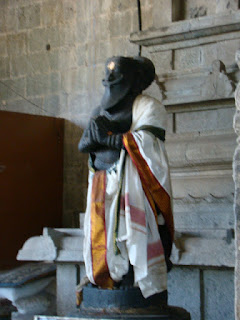Vaikuëöha Perumal Temple, Kanchipuram
After completing the prakäram, when we entered the sanctum through a flight of steep steps, we were greeted by a huge form of Viñëu on the wall. The two priests were chanting the mantras calmly with devotion without hurrying. Their chant was distinctly audible outside.
It
is a Divyadeçam dedicated to Lord Viñëu. The shrine was built by Nandivarma
Pallavamalla (731-795 CE), a few years after the construction of Kailaçanätha
Temple in Kanchi. The similarity is striking. Inscriptions and carving of
battle scenes in the bas relief around the main prakäram, refer to the wars between the Pallavas and the Gangas and
the early Chalukyas.
On
13.8.12 unknowingly we entered the temple on Vaikuntha Ekadasi day, when
special pujä and alaìkära was going on for the deity. The unique, interesting aspect
of this temple is the presence of the deity in three postures: standing, sitting
and reclining, in the basement, ground floor, and first floor respectively. The
moolavar known as Vaikuëöhanäthan is
in the sitting form, facing west. In the middle-floor, he is reclining attended
by Periya Piratti and Bhumi Devé. The top level shows Him in standing form. No pujä is reportedly offered to this form,
and we could not have darçan of this
form. The Temple is maintained by ASI, and the care shows.
After completing the prakäram, when we entered the sanctum through a flight of steep steps, we were greeted by a huge form of Viñëu on the wall. The two priests were chanting the mantras calmly with devotion without hurrying. Their chant was distinctly audible outside.
|
|
|
When we went still further up to have darçan of reclining Viñëu, another huge form
on the outer sanctum wall greeted us.
A group of devoted women were singing Näläyira-Divya-Prabandham (which has 4,000 Tamil verses of the Vaiñëava Saints, the Äÿvärs.
Out of these, the
last 1,000 Divya-Prabandham were written by Nammalvär known as Tiruvaimozhi. The ecstasy of the madhura-bhakti
of the Gopis for Kåñëa that creates a divine intoxication is the rasa of Nammalvär's poetic compositions. Classes are held to teach this reportedly. This is how
the first 500 Divya-Prabandham are learnt by the children of Iyengar family.) when
alankara was going on. We had
wonderful darçan of the deity.
Coming
out, a group of snake-deities were under the Banyan tree, showing signs of
regular worship. On the left, there was another Açvattha tree wedded to a Neem
tree, which is tradition in our culture, to bring auspiciousness, for bhüta-yajïa.
***
Work in progress.







































